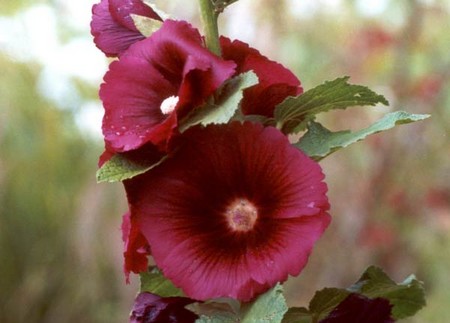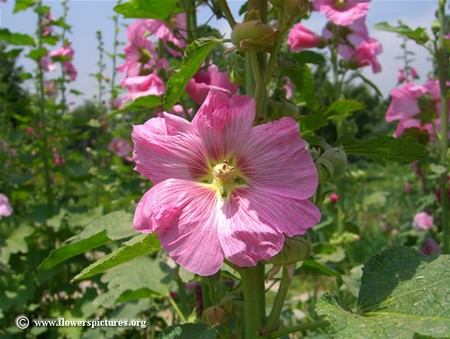The marshmallow is an attractive mild plant that grows in salt marshes and damp fertile places. The leaves are as soft as velvet. It can be grown from seed or root division and likes full sun. The flowers are followed by a ring of seeds shaped like a cheese. The tall hollyhock will grow in most soils. It originated in China where it was an emblem of fruitfulness. In Victorian England it was a symbol of female ambition, perhaps because it was said to be ruled by Venus. It was believed to grow well only at the gates of happy homes. The leaves were used to treat horse’s swollen heels, so it was originally called hock-leaf, and since it was thought to come from the holy land it became known as hollyhock.
Marshmallow and hollyhock are of the Malvaceae family, the word malva coming from malakos, Greek for soft or soothing, referring to the demulcent and emollient properties of these plants. In fact marshmallow is probably more soothing than any other plant because of its high mucilage content. Althaea comes from the Greek althane, to heal.
For the Ancient Greeks and Romans mallows were vegetables and healing herbs. The Pythagorean philosophers considered the mallow sacred because the flowers always turned towards the sun. It was for them the symbol of moderation and control of human passions, which they considered necessary for attainment of wisdom and health. Mallow is also the symbol of sweetness and mildness, and it certainly has a sugary flavour and smooth texture. The tender leaves and young tops of marshmallow are edible and can be added sparingly to salads. Mallows were eaten by the poor in Ancient Greece. Marshmallow is the origin of the soft sweets of the same name.
Herbal remedy
Marshmallow is a wonderful remedy for any kind of irritation or inflammation inside or outside the body, because of its great soothing and healing properties. The demulcent mucilage soothes the digestive, respiratory and urinary systems, while the tannins heal inflammation and ulceration of the mucous membranes. Marshmallow will help relieve heartburn and indigestion. Both as a mild expectorant and an immune enhancer it is helpful for dry, irritating coughs and chest infections.
In the urinary system, marshmallow acts as a soothing diuretic, useful in cystitis and irritable bladder, and was a traditional remedy for easing the passage of urinary gravel and stones.
Hollyhock has also been used for soothing digestive, respiratory and urinary complaints. Both plants have a cooling effect and should be thought of whenever there is excess heat and inflammation.
Marshmallow was traditionally added to herbs to ease childbirth and has also been used to improve production of breastmilk. Teething babies were given a marshmallow root to gnaw, to cool their inflamed gums. Adults used the root as a tooth cleaner.
Externally, marshmallow and hollyhock can be used in gargles for sore throats, mouth problems and spongy gums. The leaves can be applied to wasp and bee stings, and insect bites, scalds and burns, sunburn and inflammatory skin problems such as eczema and acne. They were used in the past for bruises, sprains and strains, and joint and muscular aches and pains. The leaves or pulverized root were used to draw out thorns, or as a warm drawing poultice for boils and carbuncles.
The flower essence
Mallow is used as a flower essence to engender warmth and openness. The plant used is a different mallow, Sidalcea glauscens, from the same Malvaceae family. It is particularly useful for those who feel isolated, lonely, cut off and unable to give or receive warmth and friendship. This may stem from insecurity, fear, or lack of trust related to incidents in early life. The feelings may give rise to problems making or keeping friends, or in making a commitment to a relationship.
Mallow helps to overcome such barriers to friendship, and to warm and caring relationships, and helps to soothe and ease communication.

